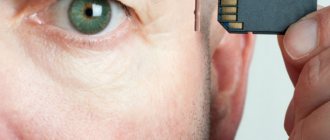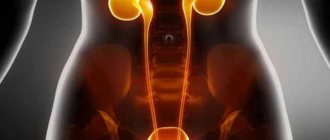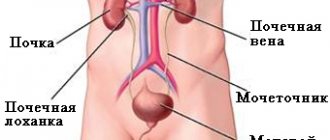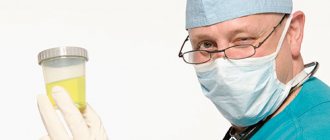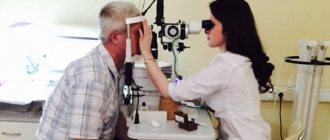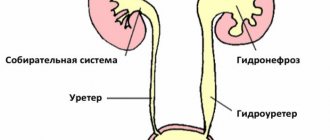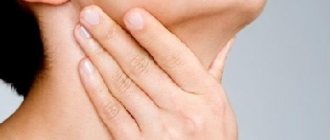Types of bile duct dyskinesia
Dyskenisia of the choleretic tract, the symptoms and treatment of which depends on the type and type of disease, can be primary and secondary. The primary form of the disease occurs against the background of dysfunction of the biliary system. The secondary form is associated with malfunctions of other systems or internal organs. Depending on the dysfunction of the sphincter, the disease is divided into 2 main types.
Types of pathology:
- Hyperkinetic or hypermotor. With this type of disease, rapid contraction of the gallbladder occurs, which leads to spasmodic contractions of the organ.
- Hypokinetic or hypomotor. The gallbladder contracts slowly, causing stagnation of bile mucus. At the same time, in the duodenum there is an insufficient amount of bile necessary for complete digestion of food.
If left untreated, the disease can progress and become chronic.
Traditional treatment
Traditional medicine recipes should complement drug treatment and in no case be a separate therapy for the disease. Moreover, you should start using them only after consulting your doctor. The specialist will recommend the optimal dosage and duration of treatment.
Most often, for dysfunction of the biliary tract, herbal components such as arnica flowers, elecampane or valerian roots, St. John's wort or lemon balm, mint or sage leaves, calendula flowers, as well as many others (immortelle, oregano, plantain, blueberry, tansy, celandine) can be used , wormwood, rose hips, dill, rose and so on).
Stages and degrees of bile duct dyskinesia
Pathology is divided into several types depending on the severity and stage of the disease. In most cases, the disease occurs in a chronic form, resulting in relapses.
During exacerbations, pain intensifies, affecting the abdominal area and radiating to the arm and back. Sleep is disturbed and headaches occur. During the period of remission, dyskinesia occurs moderately, pain is practically absent. Diet and medication are required.
Symptoms of biliary dyskinesia
Symptoms of the disease vary depending on the form and type of disease. A common symptom for all types of biliary dyskinesia is pain in the gastrointestinal tract. However, the nature of the pain may differ, which is taken into account by the treating specialist when prescribing therapy.
The presence of the disease can be determined by external signs. Patients experience a decrease in appetite, frequent belching and problems with stool. During illness, a white or yellowish coating forms on the tongue. The condition is accompanied by general body fatigue, headaches, and sleep disorders.
In the hyperkinetic form, the pain is paroxysmal in nature and occurs in most cases after eating. The pain is felt in the right hypochondrium and can radiate to the right arm or the right side of the chest. The condition does not last long and goes away on its own within 30-40 minutes.
Signs of hyperkinetic type of pathology:
- nausea;
- bloating;
- cardiopalmus;
- stool disorders - constipation followed by diarrhea;
- a feeling of bitterness in the mouth;
- occasionally - vomiting with bile impurities.
In severe cases, numbness of the limbs occurs.
The hypokinetic type of the disease is accompanied by dull and aching pain in the hypochondrium and bloating. In rare cases, pain is completely absent. The duration of attacks increases significantly and can reach several hours. The condition improves after using choleretic drugs or after eating food.
Symptoms of the hypokinetic type:
- development of itching;
- changes in the color of urine or stool;
- formation of yellowness in the whites of the eyes;
- yellowing of the skin.
In both forms, disorders of the genitourinary system are observed. In women, the menstrual cycle is disrupted; in men, libido levels decrease and erectile function decreases.
How is the disease determined?
How is the disease diagnosed? The most important thing is not to make a diagnosis yourself, based on what you read on the Internet or heard from friends. You need to see a doctor. What will the specialist do?
First of all, the doctor will personally examine the patient. Here, an important way to determine the disease is palpation of the abdomen. If a person suffers from dyskinesia, then when pressing at the moment of inhalation, the pain in the gallbladder area will be extremely severe.
Next, it will be necessary to identify the cause of the disease. To do this, the specialist will refer the patient for tests for worms and consultation with a neurologist. A general urine and blood test, liver tests, gastroduodenoscopy or intubation are also mandatory.
But the most informative method for determining the disease is ultrasound. An ultrasound is performed after eating a so-called choleretic breakfast. The examination can show not only disorders in the biliary tract, but also in the organ itself, as well as in the liver. That is, the complete picture of the disease will be visible.
Causes of biliary dyskinesia
The causes of the development of the disease are various factors. The primary form of dyskinesia is a relatively rare form of manifestation of the disease and develops against the background of abnormalities in the structure of the bile ducts or gallbladder.
The main provocateurs are various defects in the form of a bend in the organ, non-standard location of the organ, or the presence of specific partitions inside. Secondary disorders of the biliary tract develop as a result of other diseases of the internal organs.
Causes of the secondary type of dyskinesia:
- liver diseases – viral forms of hepatitis;
- disorders in the gastrointestinal tract - gastritis, cholecystitis, ulcers, appendicitis;
- inflammatory processes in the abdominal cavity;
- food allergies;
- diseases of the genital organs;
- parasitic infestations – worms, lamblia;
- infection of the bile ducts;
- chronic forms of infections - tonsillitis, pharyngitis, caries lesions.
Poor nutrition, alcohol abuse, and excessive consumption of spicy and fried foods can contribute to the development of secondary dyskinesia (hyperkinetic form).
Other reasons for the development of pathology:
- development of dysbacteriosis;
- disruptions and disturbances in the hormonal system;
- asthenia;
- passive lifestyle;
- excess body weight;
- lack of vitamins in the body.
Modern research has established a relationship between the development of biliary dyskinesia and neurotic disorders. The connection is most clearly seen in the hypokinetic form of the disease.
Traditional treatment
When it comes to green medicine cabinet recipes, you should also be careful not to harm yourself even more. Before using any folk recipes, you should definitely consult with your doctor, after which he can recommend the optimal dosage, schedule and course of administration.
Most often, decoctions are used from such plant components as calamus rhizomes, roots and leaves of barberry, birch buds and leaves, immortelle flowers, coriander fruits, corn silk, hop cones, as well as chicory herbs, wormwood, centaury, milkweed and so on.
Extracts of these plants, used for the preparation of herbal medicines, have a pronounced choleretic effect. The use of components in the form of decoctions and tinctures also helps relieve pain and improve the functioning of the gallbladder.
Diagnosis of bile duct dyskinesia
Dyskenisia of the choleretic tract, the symptoms and treatment of which depend on the form of the disease, is determined through special diagnostic measures.
Diagnostic methods:
- Initial examination and palpation. Allows you to accurately diagnose the disease by external signs and exclude other diseases associated with gastrointestinal disorders.
- Blood test to determine the level of bilirubin and lipids.
- Laboratory examination of stool. Diagnostics is carried out to determine or confirm parasitic infestations - worms, roundworms, lamblia.
- Ultrasound of the abdominal organs. It is carried out to assess the anatomical structure of the gallbladder and the ability of the walls to contract before or after eating.
- Radiography. The method is aimed at determining the speed of transport of the contents of the stomach and duodenum.
- Manometry . Diagnostics helps to determine the level of pressure in the gallbladder valve.
- MRI. It is one of the most effective research methods. Takes no more than 30-40 minutes.
In addition, a scintigraphy method may be prescribed, which allows you to visualize the required area in the form of a two-dimensional image. It is used extremely rarely. An integrated approach is used to accurately determine the disease.
You can undergo diagnostics at any medical service equipped to carry out such procedures or at a clinic at your place of residence. Prices for examinations depend on the region and medical institution.
In the centers of Moscow and the Moscow region you can find the following prices for research:
| Type of diagnosis | approximate cost |
| Consultation with a gastroenterologist | 500 rub. |
| Ultrasound examination (pancreas, gall bladder, liver and spleen) | 1800-1900 rub. |
| MRI | from 1900 rub. |
| Ultrasound of the gallbladder (study of the choleretic tract) | 1000-1100 rub. |
Possible complications
As a rule, with biliary dyskinesia, patients seek help from doctors almost immediately after the first attack of pain. But many of them, having relieved the unpleasant symptoms, stop the prescribed treatment, thereby provoking the development of complications:
- chronic cholecystitis – inflammation of the gallbladder that lasts more than 6 months in a row;
- the formation of stones in the gallbladder and its ducts – cholelithiasis;
- chronic pancreatitis – inflammation of the pancreas for 6 months;
- atopic dermatitis is a skin disease that is a consequence of a decrease in the level of immunity;
- duodenitis is an inflammatory process on the lining of the duodenum.
Biliary dyskinesia has a fairly favorable prognosis and does not shorten the patient’s life expectancy. But in the absence of proper treatment and non-compliance with the nutritionist’s recommendations, the development of the above complications is inevitable. And even these diseases are not life-threatening, but the patient’s condition will worsen significantly and eventually lead to disability.
You will receive useful advice for patients diagnosed with VSD by watching this video:
Tsygankova Yana Aleksandrovna, medical observer, therapist of the highest qualification category.
38, total, today
( 39 votes, average: 4.62 out of 5)
Splenic infarction: causes, symptoms and treatment
The first symptoms of gallbladder disease
Related Posts
When to see a doctor
Dyskenisia of the choleretic tract, the symptoms and treatment of which depend on the causes that caused the disorder, requires immediate contact with a gastroenterology specialist, regardless of the type and form of the disease. This will help prescribe timely treatment, prevent the development of complications, separate one disease from another and avoid dangerous health consequences.
The presence of the disease and diagnosis is carried out after all studies by the attending physician. The reason for therapy is an overly active or, conversely, decreased contraction of the gallbladder sphincter. If there are abnormalities in the structure of the organ, surgical intervention is required.
What are the signs of biliary dyskinesia for diagnosis?
In diagnosis, it is necessary to distinguish the listed symptoms of dyskinesia, which are related to indirect signs, accompany many diseases and do not have specificity, from objective data from instrumental examination. A medical examination provides only a presumptive diagnosis of biliary dyskinesia, which is based on the patient’s complaints, analysis of symptoms, and identification of pain sensitivity in the hypochondrium on the right.
Positive symptoms of the gallbladder are usually detected (pain at the point of projection, in the supraclavicular region on the right, when tapping on the costal arch, and others)
Prevention of bile duct dyskinesia
Preventive measures depend on the provoking factors.
Prevention methods:
- People leading a sedentary lifestyle are recommended to regularly take walks in the fresh air, do warm-up exercises, visit swimming pools, and engage in active sports.
Diskenisia of the choleretic tract. Once you recognize the symptoms, you can begin treatment. However, prevention methods include exercise. - Avoiding stressful situations.
- Taking vitamins.
- Quitting bad habits - alcohol, smoking.
- Proper nutrition. Adjustment and adherence to nutritional regimens, diet. You need to include more fresh vegetables and fruits in your diet.
- Maintaining sleep-wake patterns.
- Alternating loads and rest.
Additionally, it is recommended to undergo preventive examinations with a gastroenterology specialist 1-2 times a year.
Treatment methods for bile duct dyskinesia
The course of treatment is selected based on the established form of the pathological process. To achieve and consolidate the therapeutic effect, complex treatment is necessary, including the use of medications, traditional methods and other therapeutic procedures.
Medications
Dyskenisia of the choleretic tract, the symptoms and treatment of which are determined based on the form of the pathology, requires, first of all, the use of medications. Drug therapy is one of the main methods of treating the disease. Drugs are selected according to the type of disease. In case of hypokinetic type, drugs with a choleretic effect are prescribed.
One of the most effective and budget options is Allochol. The course of therapy lasts from 3 to 4 weeks. Adults need to take 1-2 capsules daily, 3-4 times a day. The course between breaks should be at least 1-2 months. Price per package (50 pcs.) – 60-80 rubles.
To increase the tone of the gallbladder, it is recommended to take magnesium sulfate and xylitol. Magnesium sulfate is available in the form of a powder or solution for injection and is used as a regulator of metabolic processes in the body. In powder form, to provide a choleretic effect, you must take 1 tbsp. means 3 times a day.
For constipation, the recommended dosage is 10-30 g of the product, diluted in half a glass of water. Take 1 time per day. The course of therapy is determined by the attending physician. Prices in pharmacies vary from 30 to 40 rubles.
Xylitol is a natural sugar substitute. Increases the secretion of gastric juice, fights infections and fungal infections of the gastrointestinal tract. Package price (250 g) – from 300 to 500 rubles.
Among the drugs that help improve gallbladder motility, cholecystokinin (pancreozymin) is often prescribed. The drug is a neuroleptic and restores the production of digestive enzymes. The product must be taken 2-4 capsules 4 times a day. The course of therapy depends on the severity and is determined by the attending physician.
In the hyperkinetic form, accompanied by pain, various groups of antispasmodics are used - no-spa, papaverine, drotaverine.
The recommended dosage of No-shpa is 1-2 tablets per day. The price of the drug (40 pcs.) in pharmacies is from 350 to 500 rubles. per package. To restore the movement of bile through the ducts in the hyperkinetic type of the disease, it is recommended to take Nicodin or Flamid.
Nicodin should be taken before meals, 0.5-1 g 3 to 4 times a day, with water. The course of therapy should not exceed 14 days. If necessary, the course is repeated.
Traditional methods
Among traditional medicines, corn silk, decoctions of St. John's wort, peppermint, sage, and immortelle are very popular. When bile stagnates, it is recommended to take a decoction of thistle. Pour boiling water over the herb in a ratio of 1:3 and then let it brew for 30 minutes. Take 150-200 g 3 times a day before meals until complete recovery. If necessary, the course can be repeated after a break.
For the choleretic effect:
- 4 parts dried flowers;
- 2 parts peppermint leaves;
- 2 parts red clover;
- 1 part coriander fruit.
All components must be thoroughly mixed and poured into a tin can. Use 1 tbsp as a decoction. per glass of boiling water. Place the mixture on the fire and cook for no more than 5-7 minutes. Take 100 ml warm. The course must be carried out over 2-3 weeks.
Other methods
Additional treatments may be used as adjuvant therapy. One of the most important aspects of therapy is diet. The diet plan is drawn up only after all the tests have been performed and the form of the disease has been identified. Diet plans are prescribed individually, based on the characteristics of the patient’s body.
You need to eat at least 4 and no more than 6 times a day. The break between meals should be at least 3 hours. Patients are advised to avoid overeating and monitor the temperature of food consumed - food should not be too cold or hot. It is forbidden to eat spicy, fried and fatty foods.
It is necessary to include fermented milk products in the diet and limit the consumption of animal fats.
List of prohibited foods during relapses:
- meat with high fat content;
- canned food;
- offal;
- salo;
- various smoked meats;
- salted nuts.
Prohibited list of products for hyperkinetic form of pathology:
- milk fats;
- fish;
- excessively rich broths and soups;
- vegetable oils.
For hypokinetic symptoms, these products are recommended for use. The consumption of sour cream, black bread, and eggs is allowed. It is recommended to drink mineral water and weak teas. Tea, coffee, and highly carbonated drinks are excluded from the diet.
In addition, special physical therapy (physical therapy) and physiotherapeutic procedures may be prescribed - UHF60 heating, ultrasound, magnetic therapy. The course of procedures is determined based on the established form of the disease and the presence of contraindications.
Untimely treatment of biliary dyskinesia can provoke various complications and lead to the development of other internal diseases. Symptoms of the pathology in advanced stages become more pronounced, and the patient’s general condition worsens. The most common complication of the disease is cholecystitis - an inflammatory process of the walls of the gallbladder.
With the hypokinetic type, a frequent complication is cholestasis - stagnation of bile, leading to pain, colic and the development of cholelithiasis. As a result, the pathology can lead to a complicated form - pancreatitis.
Article design: Oleg Lozinsky
Features of the treatment of dyskinesia in children
When this pathology is diagnosed, young patients are registered with a pediatric gastroenterologist and neurologist .
Every six months, children undergo an ultrasound examination and are also prescribed certain therapeutic procedures.
Treatment of the disease in question in children is similar to that prescribed for adult patients
Diet
Identical to the one described in the previous section.
In the first year of treatment, strict adherence is required. Further, in the absence of exacerbations, the diet can be gradually expanded.
Medicines
In case of hypomotor form of the disease, children are prescribed:
- Medicines that increase the motility of the bile ducts: xylitol, magnesium sulfate.
- Drugs that enhance the process of bile formation: lyobil, holagol, allohol.
For hypermotor dyskinesia, the following drugs are used:
- Antispasmodics that help reduce pain: riabal, papaverine.
- Cholerics: flamin.
3. Herbal medicine
In the hypomotor form of this disease, the main ingredients for preparing decoctions are: dandelion root, rose hips, corn silk, mint.
The basis of herbal therapy for hypermotor dyskinesia is the following pharmaceutical herbs: St. John's wort, chamomile, nettle leaves.
Therapeutic procedures
- Acupuncture for hypermotor dyskinesia.
- Neck massage.
- Electrophoresis of magnesium sulfate to enhance the motor functions of the bile ducts.
- Warm baths with pine needles have a calming effect.
- Therapeutic exercise, exposure to electric current (galvanization), and hydromassage baths help eliminate congestion in the gallbladder.
- Magnetic therapy eliminates spasm of the bile ducts.
